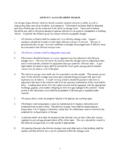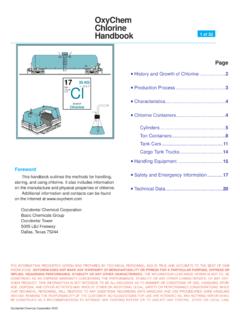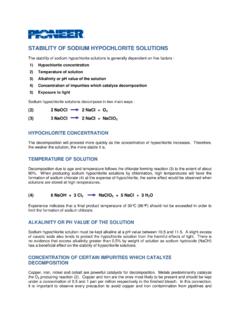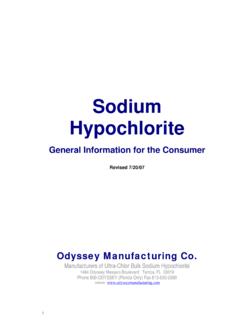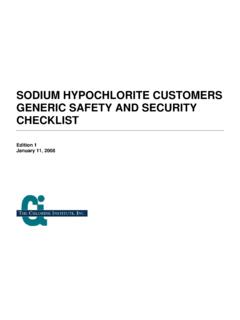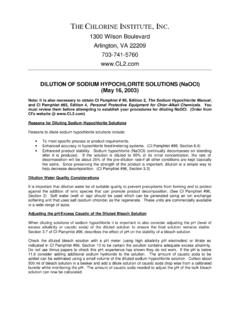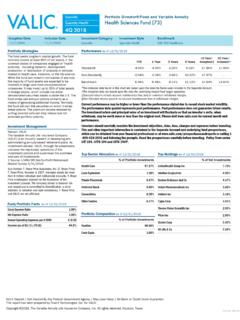Transcription of Edition 2 - Final - 5-14-08 WITH ACCEPTED CHANGES
1 Pamphlet 155 Water and WastewaterOperators ChlorineHandbookEdition 2 January 2008 i Table of Contents 1. 1 Scope .. 1 Chlorine Institute Stewardship Program .. 1 Abbreviations and 1 2 Approval .. 3 Revisions .. 3 Reproduction .. 3 2. GENERAL INFORMATION FOR WATER AND WASTEWATER 3 Usage .. 3 Physical and Chemical 3 Special Concerns for Operators .. 5 3. CHLORINE 7 7 Cylinders .. 8 Ton Containers .. 9 Cargo Tanks (Trailers) .. 11 Tank Cars (Rail) .. 11 Stationary Storage Tanks .. 11 4. TRANSPORTATION, STORAGE, AND HANDLING OF 12 Transportation of Chlorine .. 12 Receiving and Unloading Chlorine 12 Leak Detection and Correction.
2 13 General Storage Considerations .. 15 5. PIPING/FEED SYSTEMS .. 16 Basic Systems .. 16 Piping Systems for Dry 17 Vacuum 21 Vaporizers (Evaporators) .. 21 Testing Chlorine Feed Systems .. 21 Manifolding Cylinders and Ton Containers .. 21 Automatic Container 21 Role of the Chlorine Supplier .. 21 6. CONNECTING AND UNLOADING TO THE 22 Types of 22 Vapor Pressure/Temperature Relationship .. 25 Unloading/Feed 25 ii 7. BUILDING/STRUCTURE CONCERNS .. 26 Design and Construction .. 26 Electrical Systems .. 26 Ventilation and Air Openings .. 26 Heating .. 27 Absorption and Automatic Shut-Off Systems .. 27 Sprinkler Systems.
3 27 Exits and Windows .. 27 Gas 28 8. SECURITY .. 28 9. EMPLOYEE TRAINING, SAFETY, AND PERSONAL PROTECTION EQUIPMENT .. 28 Plant Employee Training .. 28 Personal Protection Equipment and 31 Other Safety Equipment .. 34 10. HANDLING 34 Planning .. 34 Establishing 35 Training .. 35 Audits and Exercises .. 37 11. MEDICAL ASPECTS .. 38 Hazards to 38 Acute Toxicity .. 39 Chronic Toxicity .. 39 CI Health Video .. 39 12. FIRST Inhalation .. 40 Contact with 42 Contact with The Eyes .. 42 13. 43 CI Publications .. 43 Directory of Organizations .. 45 APPENDIX A - SARA TITLE III REPORTING 46 APPENDIX B - OCCUPATIONAL SAFETY AND HEALTH ADMIN.
4 REGULATION .. 47 APPENDIX C - PROCESS SAFETY MANAGEMENT .. 49 APPENDIX D - RISK MANAGEMENT 50 WATER AND WASTEWATER OPERATORS CHLORINE HANDBOOK 1 1. INTRODUCTION SCOPE Chlorine is the most widely used disinfectant in water and wastewater treatment plants in the world. Although sodium and calcium hypochlorites are also used in water and wastewater treatment, this document deals only with elemental chlorine. This manual is intended to provide basic information on chlorine safety for treatment plant personnel. Throughout this text, the reader is referred to other Chlorine Institute (CI) publications for technical topics requiring detailed explanations of the subject matter or for subjects of specific interest.
5 CHLORINE INSTITUTE STEWARDSHIP PROGRAM The Chlorine Institute, Inc. (CI) exists to support the chlor-alkali industry and serve the public by fostering continuous improvements to safety and the protection of human health and the environment connected with the production, distribution and use of chlorine, sodium and potassium hydroxides, and sodium hypochlorite; and the distribution and use of hydrogen chloride. This support extends to giving continued attention to the security of chlorine handling operations. Chlorine Institute members are committed to adopting CI safety and stewardship initiatives, including pamphlets, checklists, and incident sharing, that will assist members in achieving measurable improvement.
6 For more information on the Institute s stewardship program, visit the CI website at ABBREVIATIONS AND ACRONYMS ACC American Chemistry Council ACGIH American Conference of Governmental and Industrial Hygienists AIHA American Industrial Hygiene Association ASTM American Society for Testing and Materials; now known solely by the acronym AWWA American Water Works Association CAS Chemical Abstracts Service CHEMTREC Chemical Transportation Emergency Center CFR Code of Federal Regulations CGA Compressed Gas Association CHLOREP Chlorine Emergency plan Activated Through CHEMTREC CI The Chlorine Institute, Inc. CIIT Chemical Industry Institute of Technology DOT Department of Transportation EPA Environmental Protection Agency 2 PAMPHLET 155 EPCRA Emergency Planning and Community Right-to-Know Act ERP Emergency response plan ERPG Emergency response planning guidelines HAZMAT Hazardous materials ICC International Code Council IDLH Immediately dangerous to life and health LEPC Local emergency planning committee MSDS Material safety data sheet NFPA National Fire Protection Association
7 NIOSH National Institute of Occupational Safety and Health OSHA Occupational Safety and Health Administration PEL Permissible exposure limits PPE Personal protective equipment PSM Process safety management RMP Risk management plan RMPR Risk Management Program Rule SARA Superfund Amendments and Reauthorization Act of 1986 SCBA Self-contained breathing apparatus STEL Short-term exposure limits TLV Threshold limit value TWA Time-weighted average WEF Water Environment Federation DISCLAIMER The information in this pamphlet is drawn from sources believed to be reliable. The Institute and its members, jointly and severally, make no guarantee, and assume no liability, in connection with any of this information.
8 Moreover, it should not be assumed that every acceptable procedure is included, or that special circumstances may not warrant modified or additional procedures. The user should be aware that changing technology or regulations may require CHANGES in the recommendations contained herein. Appropriate steps should be taken to ensure that the information is current, when used. These recommendations should not be confused with federal, state, provincial, municipal, or insurance requirements, or with national safety codes. WATER AND WASTEWATER OPERATORS CHLORINE HANDBOOK 3 APPROVAL The Institute s Customer Stewardship Issue Team approved Edition 2 of this pamphlet on January 3, 2008.
9 REVISIONS Suggestions for revisions should be directed to the Secretary of the Institute. REPRODUCTION The contents of this pamphlet are not to be copied for publication, in whole or in part, without prior Institute permission. 2. GENERAL INFORMATION FOR WATER AND WASTEWATER TREATMENT USAGE Chlorine's primary use in potable water treatment is as a disinfectant to destroy harmful organisms. It can also remove color and ammonia compounds, eliminate hydrogen sulfide, oxidize iron and manganese to insoluble forms, and reduce undesirable taste and odors. Chlorine's primary use in wastewater treatment is to disinfect the effluent to protect the receiving waters.
10 Other wastewater uses include the destruction of hydrogen sulfide, control of odors, removal of ammonia and ammonia compounds, control of filamentous biomass, oxidation of organics, and control of filter flies. PHYSICAL AND CHEMICAL PROPERTIES The chemical symbol for elemental chlorine is Cl. Chlorine exists as a molecule containing two atoms, shown chemically as Cl2. Chlorine has an atomic weight of , a molecular weight of , and an atomic number of 17. Some of the physical properties of chlorine are given in Table 1. While it is not explosive or flammable, as a liquid or gas it can react violently with many substances. Chlorine is only slightly soluble in water ( to by weight.)
